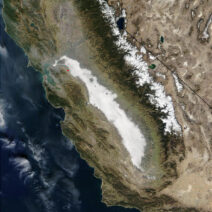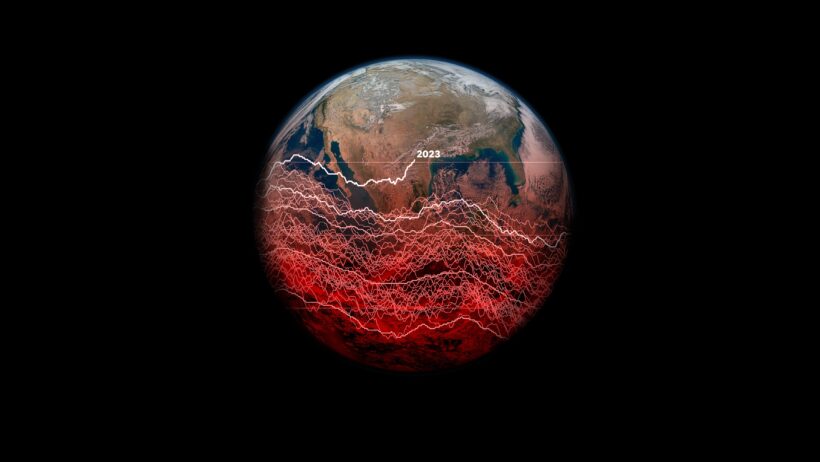The Earth is a vast and dynamic entity, constantly in motion, much like a gigantic swirling ballerina. She pirouettes through the cosmos on a stage of planetary orbs and constellations, each movement resonating with the most intricate of rhythms. Among these movements, precession stands out as a subtle yet powerful force, one which can influence not only the celestial dance of the Earth but also, indirectly, the climate we experience. Can the Earth’s precession indeed shift global temperatures? This question requires a deep dive into the mechanics of Earth’s motions, the intricate tapestry of climate systems, and the historical patterns that have shaped our planet’s climate over millennia.
To comprehend precession, one must first grasp the definition of this complex phenomenon. Precession refers to the gradual shift in the orientation of the Earth’s rotational axis, resembling the wobble of a spinning top as it decreases its velocity. This wobbling pattern unfolds over a cycle of approximately 26,000 years, a timescale that far exceeds human lifespans yet plays a critical role in long-term climatic changes. As this celestial ballet progresses, the tilt of the Earth’s axis fluctuates, affecting solar radiation distribution across the planet.
The tilt also plays a dual role in the regularity of the seasons. When combined with eccentricity—the shape of Earth’s orbit around the sun—and obliquity—the degree of axial tilt—it contributes to the Milankovitch cycles. These cycles orchestrate fluctuations in Earth’s climate, ushering in glacial and interglacial periods recognized in the annals of Earth’s geological history. Understanding these mechanisms offers insight into how precession can indeed influence global temperatures.
The pivotal question is how precession interacts with the Earth’s climate system. As the Earth tilts and orbits the sun, different hemispheres receive varying intensities of sunlight at different times of the year. For instance, during perihelion—the point in the orbit when the Earth is closest to the sun—the Southern Hemisphere receives more solar energy during its summer months compared to the Northern Hemisphere. This uneven distribution of solar energy has cascading effects on atmospheric circulation patterns, ocean currents, and, consequently, global temperatures.
More than just a fleeting phenomena, this precessional shift sets the stage for dramatic climatic transformations. Historical data reveals that significant temperature changes correlate with the Milankovitch cycles. Over the eons, variations in solar insolation—a fancy term for the amount of sunlight reaching the Earth’s surface—have catalyzed the advance and retreat of colossal ice sheets. Our current epoch, the Holocene, is a mere blink in the continuum of the Earth’s climatic evolution, shaped profoundly by these long-term cycles.
Delving deeper, one might wonder about the implications of precession in our contemporary context. While precession operates on astronomical timescales, the urgency of climate change demands immediate attention. The rapid warming we are currently experiencing cannot be attributed to precession alone; rather, it is predominantly driven by anthropogenic factors, such as greenhouse gas emissions and deforestation. Nevertheless, understanding precession enriches our knowledge of natural climate variability, providing a broader framework through which to evaluate current warming trends.
As we navigate this dialogue, it becomes essential to distinguish between natural climate drivers and human-induced impacts. While precession can signal climatic shifts over millennia, the magnitude of today’s climate crisis is unprecedented in its rapidity. The complex interactions between various climate components—atmospheric, hydrological, and biological—amplified by anthropogenic intervention, present an alarming deviation from the historical patterns observed throughout Earth’s intricate narrative.
Captivating as it may be, the relation between precession and climate is punctuated by more questions than answers. What might the future hold in terms of global temperatures as precession progresses alongside human activity? In contemplating this conundrum, one must invoke the analogy of a ship navigating through turbulent waters. As the captain of our planetary vessel, we must acknowledge the powerful currents of natural forces, combined with the tempestuous winds of human endeavor. Only through a holistic understanding of these forces can we implement effective strategies for mitigating climate change.
Additionally, the interplay of precession with atmospheric phenomena must not be disregarded. It is during times of precessional shifts that phenomena such as El Niño and La Niña are influenced, creating ripples across global weather patterns. These episodic events remind us that the climate system is a complex web of interdependencies, where each thread influences the whole. As such, variations in seasonal temperatures, precipitation patterns, and extreme weather events can all trace their roots back to these intricate celestial mechanics.
As we ponder the potent potential of Earth’s precession, it becomes clear: While it may not be the driving force behind immediate climate adversities, it undeniably plays a crucial role in the longer arc of climatic storytelling. It serves as a reminder that the Earth is not static, nor is its climate. As the planet shifts, so too must our understanding and approaches toward environmental stewardship.
In conclusion, the prospect of Earth’s precession shifting global temperatures encapsulates a beautiful symphony of cosmic mechanics and Earth’s climate narrative. As we forge ahead, let us do so with an awareness of our place within this oscillating ballet—a recognition that while the Earth spins and wobbles along its celestial path, our actions today will ultimately shape the climate of tomorrow. With coordinated efforts, embracing sustainable practices and policies, we can navigate the ship of humanity through this tempest—to preserve the beauty and sanctity of our shared blue planet.








